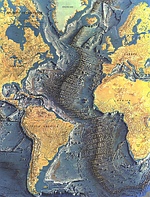Women Scientists of Lamont
In 2015 the United Nations Assembly designated February 11 as the International Day of Women and Girls in Science. This year, Lamont-Doherty joined in the festivities with a short series celebrating its women scientists.
Lamont Geological Observatory was dominated by men when it opened its doors in 1949. Marie Tharp, one of the few women there, was hired to draft figures for journal publications. Around 1951 Marie moved to the Lamont campus where she started collaborating with scientist Bruce Heezen. She went on to work closely with him for over 30 years.
Marie had training as a cartographer. In 1955, with funding from Bell Labs, she began drawing up physiographic maps which showed mountain ranges, valleys and other physical features of the Earth’s surface in perspective. Women weren’t allowed to go to sea on Lamont’s research vessel so Heezen collected data from a precision depth recorder positioned in the Atlantic, and then Marie drew the first map of the ocean floor based on the research he brought back.
Marie was able to see a V-shape which she believed was a rift valley, suggesting that the seafloor was spreading apart. Activity along the Mid Atlantic Ridge indicated that it was possible for plates to slide over the earth’s vitreous mantle, ultimately leading to the revolutionary concept of plate tectonics. Heezen didn’t pay much attention to her findings, dismissing them as “girl talk.” Like many other scientists of the day, he believed continental drift was impossible, but Marie persevered. It took a year and a half for him to be convinced and another three years before the findings were published. Jacques Cousteau was one of the disbelievers of sea-floor spreading. He set up underwater cameras to prove the pair wrong. His findings showed newly extruded lava from the center of the earth, providing the first look at the rift valley and convincing many skeptics that spreading was taking place.
In 1997 the Library of Congress named Marie as one of four greatest cartographers of the 20th century and in 2001 she was awarded the Lamont-Doherty Heritage Award for her life’s work as a pioneer of oceanography. Google Earth included the Marie Tharp Historical Map layer in 2009 allowing people to access her ocean map.
Two other world-renowned women scientists spent time at Lamont in its early days. Inge Lehman, a Dane, was an early pioneer who, in 1936, discovered the Earth’s inner core. She made numerous visits to Lamont starting in 1952 where she discovered another seismic interface in the upper mantle. In 1960, Joan Feynman who began her scientific career at Lamont before joining NASA, went on to become a world-famous astrophysicist, discovering the origins of solar activity like the aurora borealis.
These days, close to 50 percent of Lamont’s scientists are women. Some of its stars include polar geophysicist Robin Bell who studies the ice sheets of Antarctica, geo-chemist and volcanologist Terry Plank who focuses on magmas at plate margins, marine geophysicist Suzanne Carbotte who studies the formation and early evolution of the Earth’s crust at mid-ocean ridges, geophysicist Jacqueline Austermann who studies the stability of ice sheets, geochemist Sidney Hemming who documents chemical aspects of Earth’s history, paleo-ceanographer/marine geologist Maureen Raymo who works on global cooling and heating transitions, biologist/paleo-climatologist Natalie Boehman who studies the effects of changing environmental conditions on animal behavior and seismologist Meredith Nettles who studies earthquakes to understand the evolution of plate boundaries.
A slideshow showcasing more than 50 of Lamont’s women researchers illustrates the diverse fields where women in science are making critical contributions to earth science. It is available at ideo.columbia.edu


